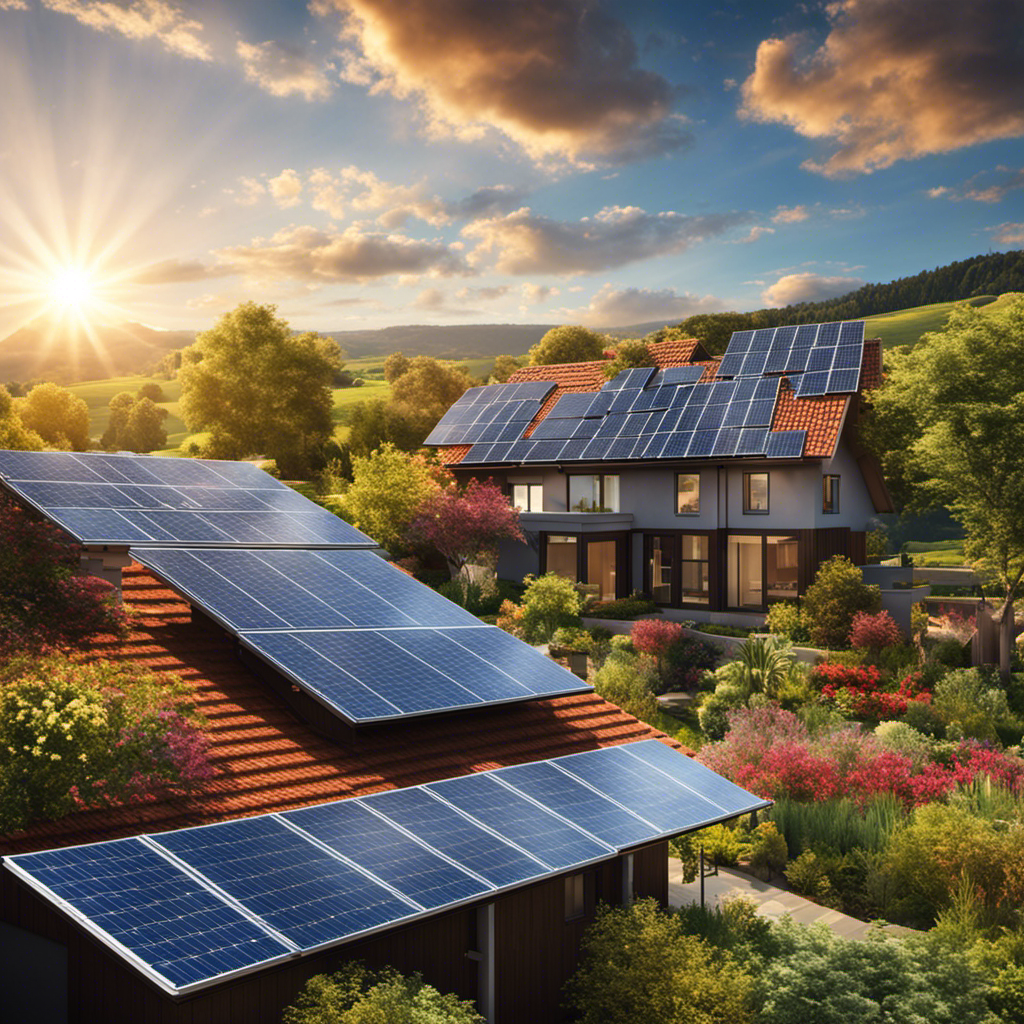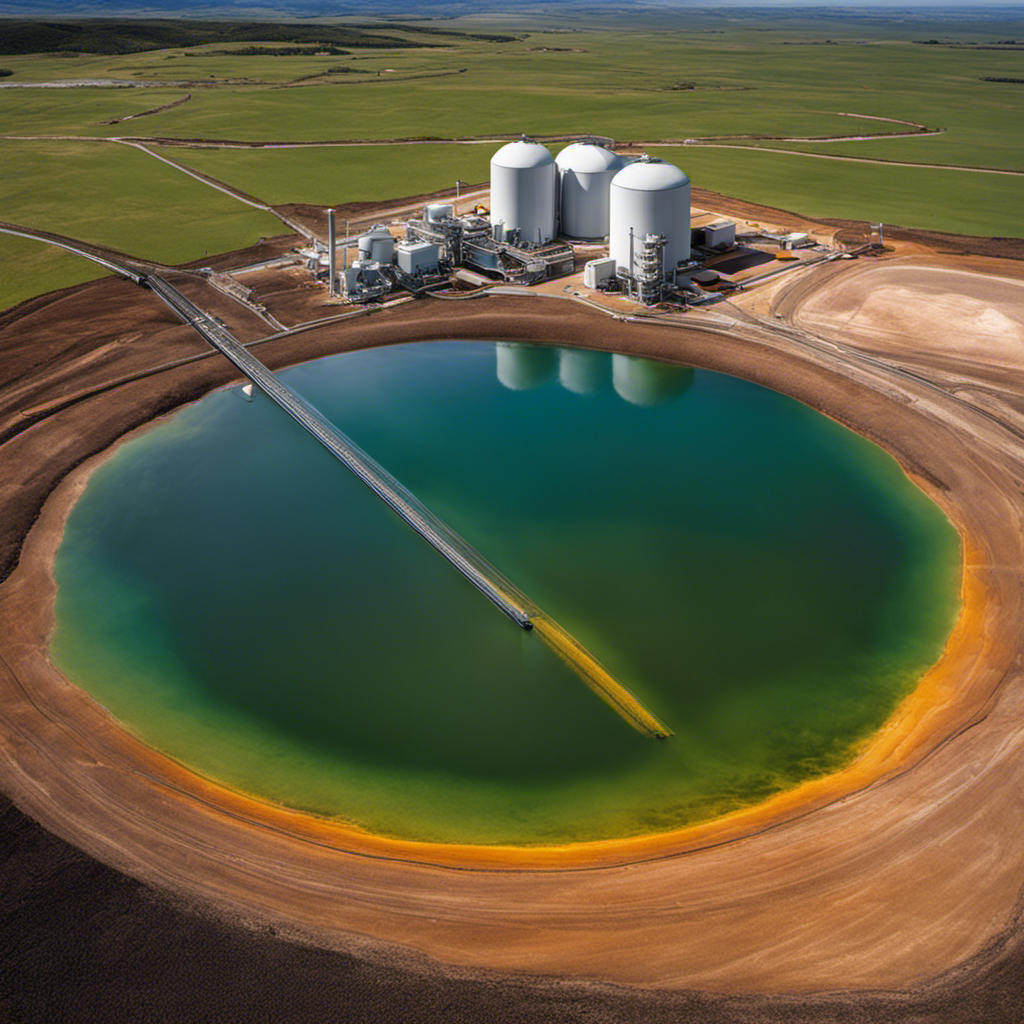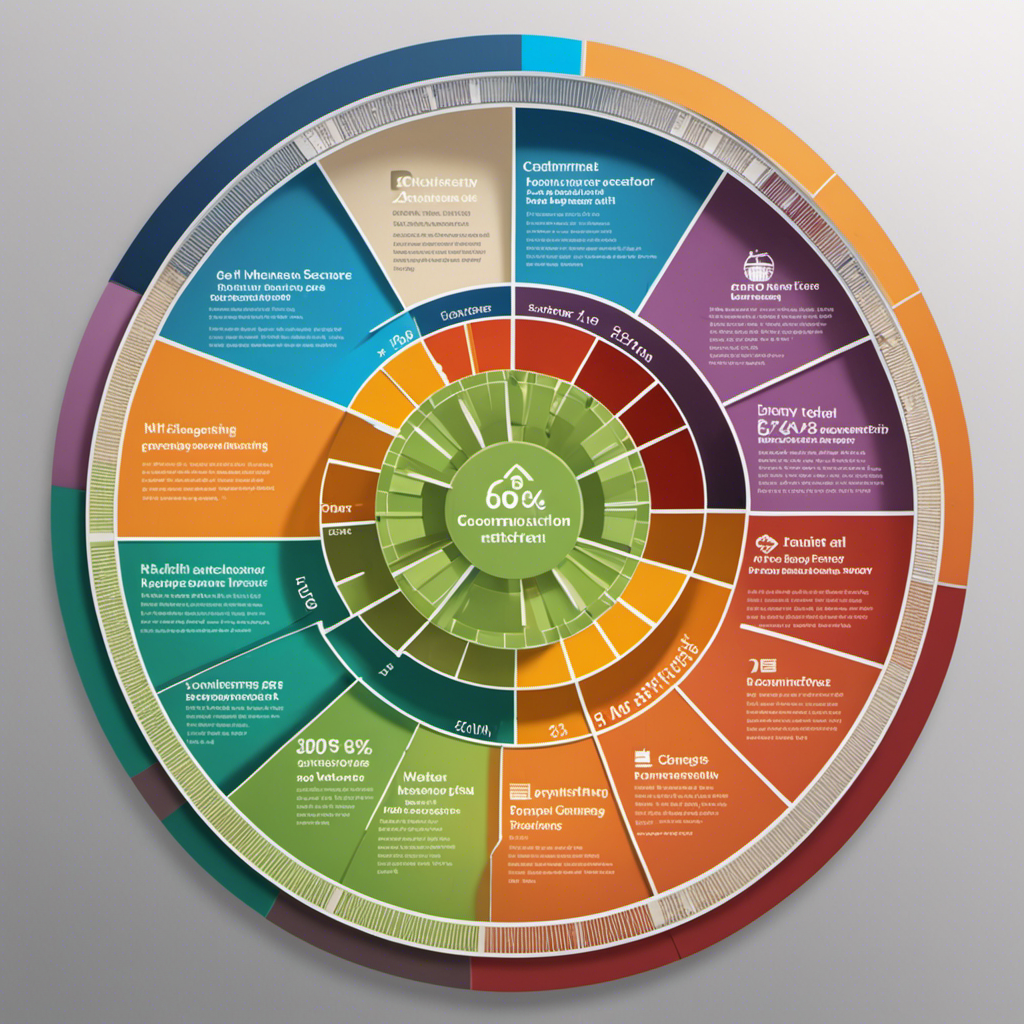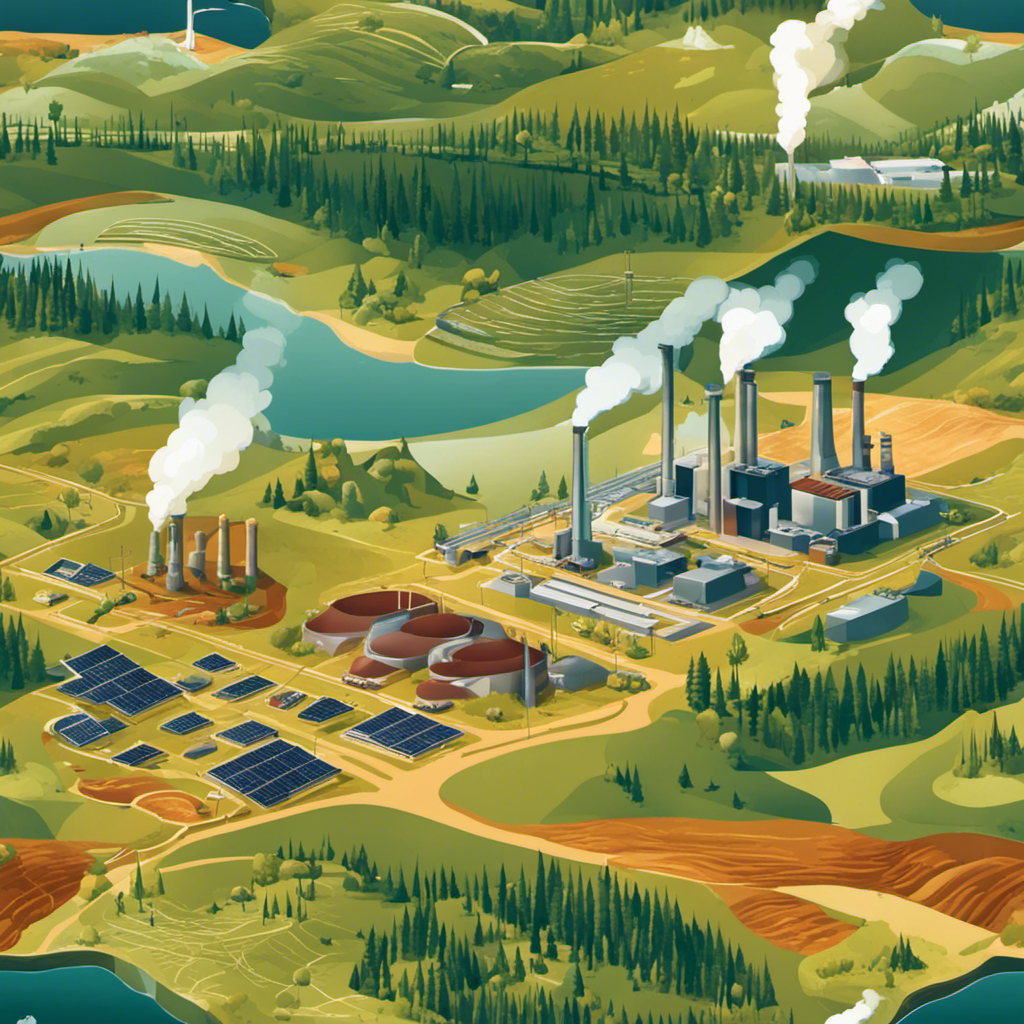Solar
What Generates The Solar Energy

As the brilliant orb of the sky, the Sun stands as the ultimate source of solar energy.
Through the ingenious technology of photovoltaic cells, sunlight is converted into electricity, powering our homes and industries.
Solar thermal systems capture the Sun’s radiant heat, providing us with warm water and space heating.
Meanwhile, concentrated solar power harnesses the Sun’s rays using mirrors and lenses, creating immense power for various applications.
Together, these technologies, along with solar panels and energy farms, form the building blocks of a sustainable energy future.
Key Takeaways
- The Sun is a massive ball of hot gases that emits solar radiation.
- Photovoltaic (PV) cells absorb sunlight and convert it into electric current.
- Solar energy storage allows for better energy management and cost savings.
- Solar thermal systems use mirrors or lenses to convert sunlight into thermal energy.
The Sun: The Ultimate Source of Solar Energy
The Sun’s rays are what generate the solar energy that powers our planet. Solar energy generation is directly dependent on solar radiation, which is the electromagnetic radiation emitted by the Sun.
The Sun is a massive ball of hot gases, primarily composed of hydrogen and helium. Through the process of nuclear fusion, the Sun releases a tremendous amount of energy in the form of radiation. This radiation travels through space and reaches the Earth, providing the primary source of solar energy.
The intensity of solar radiation varies depending on factors such as time of day, season, and location. By harnessing this abundant and renewable energy resource, we can tap into the immense power of the Sun to meet our energy needs in a sustainable and environmentally friendly manner.
Photovoltaic (Pv) Cells: Turning Sunlight Into Electricity
In this discussion, I’ll delve into the process of converting sunlight into electricity through the use of Photovoltaic (Pv) cells.
These cells, which are made up of semiconductor materials, function by absorbing photons from the sunlight and converting them into electric current.
This technology has revolutionized the way we harness solar energy, providing us with a clean and renewable source of power.
Sunlight to Electricity Conversion
Solar panels use photovoltaic cells to convert sunlight into electricity. This process is known as sunlight to electricity conversion. With advancements in technology, solar energy storage has become crucial for maximizing the utilization of solar power.
Here are some key applications and benefits of solar energy storage:
-
Grid Independence: By storing excess solar energy in batteries, households and businesses can become less reliant on the grid, reducing electricity bills and ensuring a consistent power supply.
-
Emergency Power: Solar energy storage allows for a reliable backup power source during emergencies or power outages, providing peace of mind and ensuring essential devices remain operational.
-
Time Shifting: Storing surplus solar energy during the day and utilizing it during peak demand periods allows for better energy management and cost savings.
Solar energy storage plays a vital role in expanding the reach and impact of solar energy applications, enabling a more sustainable and resilient energy future.
Function of Pv Cells
Photovoltaic cells, also known as PV cells, convert sunlight into electricity. These cells are made up of semiconducting materials, such as silicon, which absorb photons from sunlight and generate an electric current.
The efficiency of PV cells is a crucial factor in determining their performance. PV cell efficiency refers to the amount of sunlight that is converted into electricity. Higher efficiency means a greater amount of electricity can be generated from the same amount of sunlight.
Improvements in PV cell efficiency have been achieved through advancements in the manufacturing process. These include the use of thinner and more efficient materials, improved cell designs, and better encapsulation techniques.
Harnessing Solar Energy
To make the most of the sun’s power, you can take advantage of the advancements in PV cell efficiency. Harnessing solar energy has numerous advantages, including:
- Renewable: Solar energy is a sustainable source of power, as the sun’s energy is virtually limitless.
- Environmentally friendly: Unlike fossil fuels, solar energy production does not emit harmful greenhouse gases or contribute to air pollution.
- Cost-effective: Over time, the installation and maintenance costs of solar energy systems have significantly decreased, making it a more affordable option for homeowners and businesses.
These advantages highlight the potential of solar energy as a viable alternative to traditional energy sources. By harnessing the sun’s power through PV cells, we can reduce our reliance on non-renewable resources and contribute to a cleaner, greener future.
Transitioning to solar thermal systems: harnessing the heat of the sun, we can explore another aspect of utilizing solar energy.
Solar Thermal Systems: Harnessing the Heat of the Sun
Harnessing the heat of the sun, solar thermal systems use mirrors or lenses to concentrate sunlight and convert it into usable energy. These systems are designed to maximize the collection of solar heat and convert it into thermal energy for various applications.
The process involves capturing the sunlight and directing it to a receiver, which then heats a fluid or material. This heated substance can then be used for heating water, generating electricity, or even powering industrial processes.
Solar thermal systems have proven to be highly efficient in harnessing solar heat and utilizing it for thermal energy purposes. They provide a sustainable and renewable alternative to traditional energy sources, reducing greenhouse gas emissions and dependence on fossil fuels.
Moving forward, let’s explore another fascinating aspect of solar energy: concentrated solar power (CSP) and its utilization of mirrors and lenses.
Concentrated Solar Power (CSP): Utilizing Mirrors and Lenses
Utilizing mirrors and lenses, concentrated solar power (CSP) systems focus sunlight to create usable thermal energy. These systems have proven to be efficient and effective in harnessing the power of the sun.
Here are some key points about CSP:
- Mirrors and lenses are used to concentrate sunlight onto a receiver, which is usually a tube or a tower.
- The concentrated sunlight heats a fluid, such as molten salt or oil, which is then used to generate steam.
- The steam drives a turbine connected to a generator, producing electricity.
CSP technology has several advantages over other solar power systems. It provides a reliable and predictable source of energy, as it can store thermal energy for use when the sun is not shining. Additionally, CSP plants can be built at larger capacities, making them suitable for utility-scale power generation.
The use of mirrors and lenses in CSP systems maximizes the capture of sunlight, making it a highly efficient method of harnessing solar energy.
Solar Panels: The Building Blocks of Solar Energy
When it comes to solar energy, there are three key points that are worth discussing: solar panel efficiency, cost of installation, and environmental benefits.
Solar panel efficiency refers to how well the panels can convert sunlight into usable energy. The higher the efficiency, the more energy can be generated from a given amount of sunlight.
The cost of installation is an important factor to consider because it determines the upfront investment required to set up a solar energy system.
Lastly, the environmental benefits of solar energy are significant, as it is a clean and renewable source of power that reduces greenhouse gas emissions and dependence on fossil fuels.
Solar Panel Efficiency
To get the most out of your solar panels, you’ll want to make sure they are operating at maximum efficiency. Solar panel technology has come a long way in recent years, offering improved efficiency and higher energy production.
Here are three key factors that can help improve the efficiency of your solar panels:
-
Optimal positioning: Ensuring that your panels are facing the sun directly and at the right angle can significantly increase their efficiency. Tracking systems and adjustable mounts can help achieve this.
-
Regular maintenance: Keeping your solar panels clean and free from debris is crucial for optimal efficiency. Regular inspections and cleaning can prevent any build-up that may hinder their performance.
-
Upgrading technology: Keeping up with advancements in solar panel technology can greatly improve efficiency. Newer panels often have higher conversion rates and improved durability, leading to increased energy production.
Cost of Installation
The cost of installing solar panels can vary depending on factors such as the size of the system and any additional equipment needed. To give you a better understanding of the cost benefits of solar panel installation, let’s take a look at the table below:
| Size of System (kW) | Average Installation Cost ($) | Estimated Annual Savings ($) |
|---|---|---|
| 3 | $9,000 | $1,200 |
| 5 | $15,000 | $2,000 |
| 7 | $21,000 | $2,800 |
| 10 | $30,000 | $4,000 |
As you can see, the larger the system, the higher the installation cost, but also the greater the annual savings. The installation process typically involves a site assessment, obtaining permits, mounting the panels, and connecting the system to your electrical grid. It is important to note that these costs and savings are estimates and can vary based on location and other factors. However, investing in solar panels can provide long-term cost benefits and contribute to a more sustainable future.
Environmental Benefits
Installing solar panels can have a positive impact on the environment by reducing carbon emissions. Solar energy is a renewable source of power that harnesses the sun’s rays to generate electricity. This clean and sustainable energy option offers several environmental benefits:
-
Reduced greenhouse gas emissions: Solar panels produce electricity without burning fossil fuels, resulting in significantly lower carbon dioxide emissions. This helps combat climate change and reduces air pollution.
-
Conservation of natural resources: Solar energy does not require the extraction or consumption of finite resources like coal or natural gas. By relying on the sun’s energy, we can preserve these valuable resources for future generations.
-
Protection of ecosystems: Solar energy production does not involve harmful byproducts or waste, minimizing the negative impact on local ecosystems and biodiversity.
Solar Energy Farms: Large-Scale Generation of Solar Power
Solar energy farms are responsible for the large-scale generation of solar power. These farms are designed to capture and convert sunlight into electricity through the use of photovoltaic (PV) panels. The generated electricity can be used to power homes, businesses, and even entire communities.
One of the challenges of solar energy farms is the storage of excess energy for times when the sun is not shining. To address this issue, various methods of solar energy storage have been developed, such as batteries and thermal storage systems.
Additionally, grid integration plays a crucial role in the success of solar energy farms. By connecting these farms to the electrical grid, the surplus energy can be exported to other areas, while the grid provides power during times of low solar generation. This integration ensures a reliable and continuous supply of electricity.
Frequently Asked Questions
How Does Solar Energy Compare to Other Sources of Renewable Energy?
Solar energy is a promising source of renewable energy due to its cost comparison and recent technological advancements. Compared to other sources, such as wind or hydroelectric power, solar energy is becoming increasingly affordable and accessible.
Technological advancements have led to more efficient solar panels and improved energy storage systems. These developments have made solar energy a viable option for many households and businesses alike.
As we continue to invest in research and development, solar energy will play a crucial role in our transition to a sustainable future.
What Are the Main Challenges in Storing and Distributing Solar Energy?
When it comes to solar energy, the main challenges lie in storage and distribution.
The issue with storage is finding efficient and cost-effective methods to store the energy generated by solar panels. This is crucial because solar energy is not always available when it is needed, such as during cloudy days or at night.
As for distribution, the challenge is developing a robust infrastructure to transmit solar energy from remote locations to urban areas where it is needed the most.
Are There Any Environmental Impacts Associated With Solar Energy Production?
There are several environmental benefits associated with solar energy production. One of the main advantages is its minimal impact on wildlife compared to other forms of energy generation. Solar panels do not emit greenhouse gases or pollutants during their operation, reducing air and water pollution.
Additionally, solar energy does not require the extraction of finite resources, minimizing habitat destruction and land degradation. These factors make solar energy a sustainable and environmentally-friendly alternative to conventional energy sources.
How Does the Efficiency of Solar Panels Differ Between Different Geographical Locations?
Efficiency factors and geographical variations play a significant role in the performance of solar panels. The efficiency of solar panels can differ between different geographical locations due to factors like sunlight intensity, temperature, and shading. These variations impact the amount of solar energy that can be generated and harvested.
Understanding these geographical differences is crucial for optimizing the efficiency and output of solar panel installations. Research and data analysis are essential in determining the most suitable locations for solar energy production.
What Is the Economic Viability of Solar Energy and How Does It Compete With Traditional Energy Sources?
The economic viability of solar energy is a topic of great interest in today’s market. As traditional energy sources become more expensive and environmentally damaging, solar energy offers a promising alternative.
Its economic benefits are evident in the long-term cost savings and the potential for job creation. Furthermore, solar energy is becoming increasingly competitive in the market, with advancements in technology and government incentives driving its adoption.
As a result, solar energy is poised to play a major role in our future energy landscape.
Conclusion
In conclusion, it is clear that solar energy is not just a fad, but a revolutionary form of power generation. The Sun, our mighty celestial overlord, graciously provides us with an abundance of energy.
Through the marvels of photovoltaic cells, solar thermal systems, concentrated solar power, and solar panels, we have harnessed this divine gift and transformed it into usable electricity.
The future lies in vast solar energy farms, where we can bask in the glory of sustainable power. So let us embrace the brilliance of the Sun and embark on a new era of clean and renewable energy.
Solar
Solar Energy and Environmental Education

Passionate about a sustainable future, I’m excited to reveal the amazing **benefits** of solar energy and how it helps teach us about protecting our environment. Explore this illuminating journey and discover the wonders of harnessing the sun’s energy for a cleaner world!
Solar energy is a game-changer, providing countless benefits for both our planet and future generations.
In this article, we will explore how we can integrate solar energy into the curriculum, promote renewable energy awareness, and engage students in sustainable practices.
Together, let’s harness the power of the sun to create a brighter, more sustainable world.
Key Takeaways
- Solar energy is a highly efficient and clean source of power, reducing air pollution and combating climate change.
- Integrating solar energy into the curriculum enhances student engagement and fosters a deeper understanding of sustainable practices.
- Promoting renewable energy awareness through workshops, collaborations, and social media platforms is crucial for building a sustainable future.
- Engaging students in sustainable practices empowers them to make positive changes in their own lives and instills a sense of responsibility towards the environment.
The Benefits of Solar Energy
I’m convinced that solar energy offers numerous environmental and economic benefits.
One of the major advantages of solar energy is its efficiency. Solar panels convert sunlight directly into electricity, which means that there are no energy losses during transportation or distribution. This makes solar energy one of the most efficient forms of renewable energy available today.
Additionally, solar energy is a clean source of power, meaning that it produces no harmful emissions or pollutants. This helps to reduce air pollution and combat climate change.
Moreover, solar energy is a reliable and sustainable resource as long as the sun continues to shine. With advancements in technology, the efficiency of solar panels has also improved, making them even more cost-effective for homeowners and businesses.
Overall, solar energy offers a range of advantages in terms of efficiency, environmental sustainability, and economic benefits.
Integrating Solar Energy Into the Curriculum
As an educator, I’ve found that integrating solar power into the curriculum enhances student engagement and fosters a deeper understanding of sustainable practices. By incorporating solar energy applications and renewable energy integration into various subjects, students not only learn about the science behind solar power but also develop critical thinking skills and problem-solving abilities.
They become aware of the environmental benefits of renewable energy sources and gain a sense of responsibility towards preserving our planet. Through hands-on activities, such as building solar-powered devices or conducting experiments with solar panels, students can see firsthand how solar energy works and its potential for a greener future.
Promoting Renewable Energy Awareness
Promoting renewable energy awareness is crucial for building a sustainable future. As someone passionate about renewable energy, I understand the importance of community outreach and education. By organizing renewable energy workshops, we can provide valuable information and resources to our community.
Here are three ways we can effectively promote renewable energy awareness:
-
Hosting workshops: These interactive sessions will educate individuals about the benefits of renewable energy and how they can incorporate it into their daily lives.
-
Collaborating with local organizations: By partnering with local environmental groups or community centers, we can reach a wider audience and increase the impact of our outreach efforts.
-
Utilizing social media: Sharing informative content, success stories, and practical tips on platforms like Facebook and Instagram can engage and inspire a larger online community.
Together, through community outreach and renewable energy workshops, we can create a more sustainable future for generations to come.
Engaging Students in Sustainable Practices
Engaging students in sustainable practices is a key aspect of creating a greener future. By involving students in green initiatives and encouraging their active participation, we can cultivate a generation of environmentally conscious individuals. Educating students about sustainable practices not only empowers them to make positive changes in their own lives, but also instills a sense of responsibility towards the environment.
One effective way to engage students is by incorporating sustainability into the curriculum. By integrating topics like renewable energy, waste reduction, and conservation into various subjects, we can provide students with a comprehensive understanding of sustainable practices. Additionally, hands-on activities and interactive projects can further enhance their learning experience.
Furthermore, student participation in sustainability initiatives can extend beyond the classroom. Schools can organize events like tree planting, recycling drives, and energy conservation campaigns, where students actively participate and contribute to making a difference. These practical experiences not only reinforce the importance of sustainable practices but also foster a sense of ownership and environmental stewardship among students.
Collaborating With Communities for a Greener Future
Collaborating with communities is essential for creating a greener future. By forming strong community partnerships, we can work together to implement sustainable initiatives that have a lasting impact on the environment.
Here are three key benefits of collaborating with communities:
-
Increased awareness: When we partner with communities, we can raise awareness about the importance of sustainability and the benefits of renewable energy sources like solar power. By engaging with community members, we can educate them about the positive impact of sustainable initiatives and inspire them to take action.
-
Local expertise: Communities possess valuable knowledge about their specific needs and challenges. By collaborating with them, we can tap into this local expertise and tailor our sustainable initiatives to address their unique circumstances. This ensures that our efforts are effective and sustainable in the long run.
-
Shared resources: Working together with communities allows us to pool our resources and achieve greater impact. By combining our expertise, funding, and manpower, we can implement larger-scale projects that benefit not only the community but also the environment as a whole.
Through strong community partnerships and sustainable initiatives, we can create a greener future that benefits everyone. Let’s join forces and make a positive change together.
Frequently Asked Questions
Are There Any Disadvantages or Limitations to Using Solar Energy?
There are indeed some disadvantages and limitations to using solar energy.
One major limitation is that solar panels can only generate electricity when the sun is shining, so they aren’t as reliable during cloudy or nighttime conditions.
Additionally, solar energy can be expensive to install and maintain, making it less accessible for some individuals or communities.
Another drawback is the large amount of space required for solar farms, which may not be feasible in densely populated areas.
How Does Solar Energy Compare to Other Renewable Energy Sources in Terms of Efficiency and Cost?
When comparing solar energy to other renewable energy sources in terms of efficiency and cost, it’s important to consider the numbers.
Efficiency-wise, solar panels have come a long way, with average conversion rates of 15-20%. This means that 15-20% of sunlight is converted into usable electricity.
In terms of cost, solar energy is becoming increasingly affordable, with prices dropping by 89% in the last decade. This makes solar energy a highly efficient and cost-effective choice for renewable energy.
What Are Some Potential Challenges or Barriers Educators May Face When Integrating Solar Energy Into the Curriculum?
When it comes to integrating solar energy into the curriculum, educators may face several challenges and barriers.
These can include a lack of resources and funding for solar installations, limited access to training and professional development opportunities, and resistance from stakeholders who may not see the value in incorporating solar energy into the curriculum.
Additionally, there may be logistical challenges in terms of finding appropriate curriculum materials and ensuring that students have the necessary knowledge and skills to participate in solar energy projects.
How Can Students Actively Participate in Promoting Renewable Energy Awareness Within Their Communities?
As a student, I believe that student-led initiatives are crucial in promoting renewable energy awareness within our communities. By actively engaging with our peers and community members, we can organize events and campaigns that educate and inform others about the benefits of renewable energy.
Through workshops, presentations, and hands-on projects, we can inspire others to take action and make a positive impact on our environment. It’s essential that we work together to create a sustainable future for generations to come.
What Are Some Successful Examples of Collaborative Projects Between Schools and Communities to Promote Sustainable Practices and Solar Energy Adoption?
Collaborative projects between schools and communities can have a significant impact on promoting sustainable practices. By working together, we can create innovative initiatives that encourage the adoption of solar energy and other renewable sources.
These projects allow students to actively participate in real-world scenarios, fostering a sense of responsibility and awareness towards environmental issues. Through hands-on experiences, students gain a deeper understanding of the benefits of sustainable living and the positive impact it has on our planet.
In addition to educating students, these collaborations also inspire and engage the wider community. By showcasing successful sustainable projects, schools and communities can encourage others to follow suit and implement similar initiatives. This ripple effect can lead to a widespread adoption of sustainable practices, ultimately contributing to a more environmentally friendly society.
Conclusion
As I reflect on the power of solar energy and environmental education, I’m reminded of the sun’s unwavering presence in our lives. Just as the sun provides light and warmth, solar energy illuminates our path towards a greener future.
By integrating solar energy into our curriculum and promoting renewable energy awareness, we empower our students to be the catalysts of change.
Together, let’s harness the energy of the sun and create a sustainable world for generations to come.
Solar
Who Benefits Most From Solar Energy, Who The Least

I have always been curious about the individuals or groups that are most and least impacted by solar energy. As solar energy continues to gain popularity, it is crucial to consider the economic inequalities and social consequences associated with its adoption.
In this article, we’ll explore the government policies and support for solar energy, as well as the challenges faced by low-income communities in embracing this renewable source.
Join me as we delve into solutions for ensuring the equitable distribution of solar energy benefits.
Key Takeaways
- Economic disparities and financial constraints hinder access to solar energy for low-income communities and developing countries.
- The adoption of solar energy has positive social and environmental impacts, including reduced greenhouse gas emissions, job creation, and improved quality of life.
- Government policies and incentives have helped make solar energy more affordable and driven investment in renewable energy projects.
- Challenges for low-income communities in embracing solar energy include limited access to capital, lack of knowledge, and limited community engagement. Overcoming these barriers requires community partnerships, education, and financial support.
Economic Disparities and Solar Energy Access
I believe that economic disparities play a significant role in determining who has access to solar energy and who does not.
Economic inequality and energy poverty are closely tied to the availability and affordability of solar energy solutions. According to data, low-income communities and developing countries face greater challenges in accessing solar energy due to financial constraints.
High upfront costs, installation expenses, and maintenance fees make it difficult for economically disadvantaged individuals to adopt solar energy systems. This perpetuates a cycle where those who can afford it benefit from the advantages of solar power, such as reduced electricity bills and environmental benefits, while others are left behind.
Bridging the economic gap and providing financial support to underserved communities is crucial in ensuring equitable access to solar energy and addressing energy poverty.
Social and Environmental Impact of Solar Energy Adoption
As a homeowner, my monthly electricity bills have significantly decreased since adopting solar energy, positively impacting both my wallet and the environment.
The transition to renewable energy hasn’t only empowered my community but also led to various social and environmental benefits.
According to data, solar energy adoption has reduced greenhouse gas emissions, contributing to a cleaner and healthier environment.
It has also created job opportunities, stimulating economic growth and community empowerment.
Additionally, solar energy has provided reliable and affordable electricity to underserved areas, bridging the energy access gap and improving the quality of life for many.
Government Policies and Support for Solar Energy
The government’s commitment to promoting renewable energy through favorable policies and financial incentives has greatly accelerated the adoption of solar power. Government incentives, such as tax credits and grants, have provided financial support to homeowners, businesses, and utilities to invest in solar energy systems. These incentives have helped reduce the upfront costs of installation and made solar power more affordable for many.
In addition, the government has set renewable energy targets to encourage the transition to clean energy sources. These targets have created a sense of urgency and have driven investment in solar energy projects. As a result, the solar industry has experienced significant growth, creating jobs and reducing greenhouse gas emissions.
However, despite these government efforts, there are still challenges for low-income communities in embracing solar energy.
Challenges for Low-Income Communities in Embracing Solar Energy
Low-income communities face financial barriers that hinder their ability to adopt solar power and benefit from the cost savings and environmental advantages it offers. Many factors contribute to these challenges, including limited access to capital, lack of knowledge about solar energy, and the absence of community engagement initiatives.
To illustrate the extent of these challenges, let’s consider the following table:
| Challenges | Impact on Low-Income Communities |
|---|---|
| Limited Access to Capital | Prevents investment in solar infrastructure |
| Lack of Knowledge | Hinders understanding of solar benefits and technology |
| Absence of Community Engagement Initiatives | Limits awareness and support for solar initiatives |
To overcome these barriers, it is crucial to focus on community engagement, education, and awareness. By providing accessible information, training, and financial assistance programs, we can empower low-income communities to embrace solar energy and reap its benefits. Encouraging partnerships between solar companies, government agencies, and community organizations can also play a significant role in overcoming these challenges.
Solutions for Ensuring Equitable Distribution of Solar Energy Benefits
To ensure equitable distribution of solar power advantages, I believe it’s crucial to prioritize accessibility and inclusivity in the implementation of solar energy initiatives.
By forming strong community partnerships, we can ensure that solar energy benefits are accessible to all, regardless of income or social status. These partnerships can help identify and address the specific needs of different communities, ensuring that solar energy initiatives are tailored to their requirements.
Additionally, providing financial incentives can further encourage the adoption of solar energy in low-income communities. These incentives can include grants, tax credits, or subsidies that make solar energy more affordable for those who need it the most.
Frequently Asked Questions
What Are the Potential Health Benefits of Solar Energy Adoption for Low-Income Communities?
Solar energy adoption has the potential to bring significant health benefits to low-income communities. By reducing air pollution and improving overall environmental quality, solar energy can contribute to environmental justice and promote community health.
How Do Government Subsidies and Incentives Impact the Affordability of Solar Energy for Different Income Groups?
Government incentives play a crucial role in making solar energy affordable for different income groups. However, income disparity can limit access to these benefits, creating a need for targeted policies to ensure equal opportunities for all.
How Does the Installation and Maintenance of Solar Panels Affect Property Values in Low-Income Communities?
The installation and maintenance of solar panels in low-income communities can positively impact property values and provide health advantages. This can lead to increased affordability and access to clean energy for those who need it most.
Are There Any Potential Drawbacks or Unintended Consequences of Widespread Solar Energy Adoption in Low-Income Neighborhoods?
There are potential drawbacks and unintended consequences of widespread solar energy adoption in low-income neighborhoods. These include increased costs for residents, potential displacement, and unequal access to benefits.
What Are Some Innovative Financing Options or Community-Led Initiatives That Aim to Increase Access to Solar Energy for Disadvantaged Communities?
Innovative financing options and community-led initiatives are key to increasing access to solar energy for disadvantaged communities. These solutions can help address barriers and ensure that everyone can benefit from the advantages of solar energy.
Conclusion
In conclusion, while solar energy has the potential to benefit all communities, there are still economic disparities that affect access and distribution. According to a recent study, it was found that low-income households make up only a small percentage of solar energy adopters.
This highlights the need for government policies and support to ensure equitable distribution of solar energy benefits. By addressing these challenges, we can work towards a more inclusive and sustainable future powered by solar energy.
Solar
How Many Solar Panels Do I Need On My House To Become Energy Independent

So, you’re interested in achieving energy independence, huh? Get ready because we’re about to explore the realm of solar panels.
In this article, I’ll break down the factors that affect the number of panels you’ll need to power your house. We’ll calculate your energy consumption, evaluate available sunlight, and determine panel efficiency.
By the end, you’ll have a clearer picture of just how many solar panels it takes to break free from the grip of the grid.
Key Takeaways
- The amount of sunlight received and solar panel efficiency are key factors that affect energy generation.
- Analyzing monthly electricity bills and understanding net metering are important for calculating energy consumption and potential savings.
- Evaluating available sunlight, including potential shading factors and optimizing panel placement, is crucial for maximizing solar potential.
- Considering cost implications, maintenance requirements, and energy consumption patterns are essential for determining the ideal number of solar panels needed.
Factors Affecting Solar Panel Requirements
One of the factors that affects the number of solar panels I need for my house to become energy independent is the amount of sunlight my location receives. The more sunlight I receive, the more energy my solar panels can generate. This is an important consideration because it directly impacts the effectiveness and efficiency of the solar panels.
Additionally, cost considerations play a significant role in determining the number of solar panels needed. The upfront cost of installing solar panels can be expensive, so it’s essential to carefully calculate the number of panels required to maximize energy production while keeping costs manageable.
Fortunately, there are government incentives available that can help offset the cost of installing solar panels, such as tax credits and rebates. These incentives can make solar panel installation more affordable and encourage homeowners to invest in renewable energy sources.
Calculating Energy Consumption
To calculate my energy consumption, I’ll need to analyze my monthly electricity bills and determine the average amount of energy I use per month. This is crucial in understanding how many solar panels I’ll need to become energy independent.
By examining my bills over a year, I can get a better estimate of my energy usage patterns and identify any seasonal variations. Once I’ve this information, I can start estimating the costs of installing enough solar panels to cover my energy needs.
It’s important to consider the concept of net metering, which allows me to sell excess energy back to the grid. Understanding net metering will help me determine how many solar panels I’ll need to generate enough energy to offset my consumption and potentially earn credits from my utility company.
Evaluating Available Sunlight
I can evaluate the amount of sunlight that my location receives throughout the year by analyzing historical weather data and using online resources. This information is crucial for evaluating the solar potential of my property and optimizing panel placement.
Here are three key factors to consider when evaluating sunlight availability:
-
Sunlight Duration: Analyzing historical weather data will provide insight into the average number of sunny days and the duration of sunlight in my area. This information helps determine the overall solar potential.
-
Shading: Assessing the potential shading factors in my location is essential. Obstructions such as trees, buildings, or nearby structures can significantly impact the amount of sunlight that reaches my solar panels.
-
Sun Path: Understanding the sun’s path is crucial for optimizing panel placement. By knowing the direction and angle of sunlight throughout the year, I can position my solar panels to capture the maximum amount of energy.
Determining Panel Efficiency
Analyzing the efficiency ratings of different solar panels is crucial in determining which ones will generate the most electricity for my property. Maximizing output and optimizing performance are key factors in achieving energy independence through solar power.
When evaluating solar panels, it’s important to consider their efficiency ratings, which indicate how effectively they convert sunlight into electricity. Higher efficiency ratings mean that the panels can generate more electricity from the same amount of sunlight.
Finding the Ideal Number of Solar Panels
By determining the ideal number of solar panels for my property, I can ensure that I’m maximizing the amount of electricity generated. There are several factors to consider when finding the right number of panels for my needs:
-
Cost considerations: The number of panels will impact the initial cost of the system. More panels mean a higher upfront investment, but they also result in greater energy production and potential savings in the long run.
-
Maintenance requirements: Each panel requires regular cleaning and inspection to ensure optimal performance. Having too many panels can increase the maintenance workload, while having too few may not generate enough energy to meet my needs.
-
Energy consumption: It’s essential to analyze my household’s energy consumption to determine the number of panels required. By understanding my energy usage patterns, I can accurately estimate the number of panels needed to achieve energy independence.
Considering these factors, I can make an informed decision and find the ideal number of solar panels for my property.
Frequently Asked Questions
How Long Do Solar Panels Typically Last Before Needing to Be Replaced?
Solar panels typically last around 25-30 years before needing to be replaced, although some warranties can extend up to 40 years. Factors like weather conditions, maintenance, and quality of materials can affect their lifespan.
Are There Any Government Incentives or Tax Credits Available for Installing Solar Panels?
There are government incentives and tax credits available for installing solar panels. These incentives can help offset the installation costs and shorten the payback period, making solar energy more affordable and attractive.
Can I Sell Excess Energy Generated by My Solar Panels Back to the Power Grid?
Yes, you can sell excess energy generated by your solar panels back to the power grid. It’s a great way to offset your electricity costs and make your solar panel investment even more efficient.
What Kind of Maintenance Is Required for Solar Panels?
Solar panel cleaning and inspection are crucial for maintaining optimal performance. Regular cleaning removes dirt and debris that can hinder efficiency, while inspections ensure any issues are detected and resolved promptly.
How Does the Cost of Installing Solar Panels Compare to the Cost of Traditional Electricity?
Installing solar panels is a cost-effective and environmentally friendly alternative to traditional electricity. It reduces the reliance on fossil fuels and can save on monthly bills. The initial investment is offset by long-term savings.
Conclusion
After carefully evaluating factors such as energy consumption, available sunlight, and panel efficiency, it’s clear that the ideal number of solar panels needed to achieve energy independence varies for each household.
Becoming energy independent is a personal journey, but with the right information and resources, it’s an achievable goal. By harnessing the power of the sun, we can’t only reduce our reliance on traditional energy sources but also contribute to a cleaner and more sustainable future.
-

 Sustainable Supply Chain Management5 months ago
Sustainable Supply Chain Management5 months agoManagEnergy Acquires GPST2030.org Domain to Strengthen Commitment to Sustainable Transport
-

 Wind Energy5 months ago
Wind Energy5 months agoHow Much Oil Does It Take To Lubricate A Wind Turbine
-

 Electric Motorbike3 months ago
Electric Motorbike3 months agoCalifornia Electric Motorcycle Laws: A Comprehensive Guide to Riding Safely
-

 Solar4 months ago
Solar4 months agoIn 2009, About What Percent Of U.S. Energy Consumption Was Supplied By Solar Energy
-

 Electricity Vehicle3 months ago
Electricity Vehicle3 months agoThe Future of Electric Vehicles: Trends and Innovations to Watch
-

 Wind Energy3 months ago
Wind Energy3 months agoRevolutionizing Highways: Wind Turbines Take the Road to Renewable Energy
-

 Solar4 months ago
Solar4 months agoWhy Should We Use Solar Energy Instead Of Fossil Fuels
-

 Wind Energy4 months ago
Wind Energy4 months agoWhat Is The Minimum And Maximum Wind Speed For Operating A Wind Turbine





















